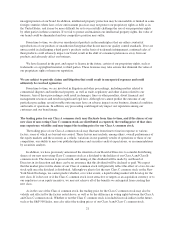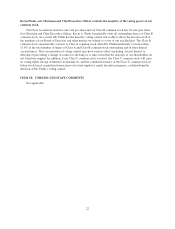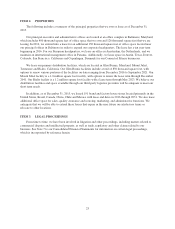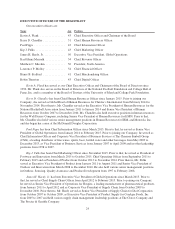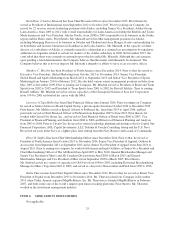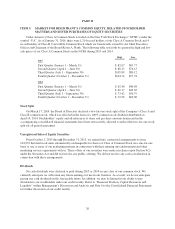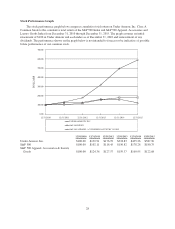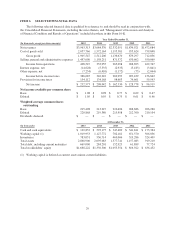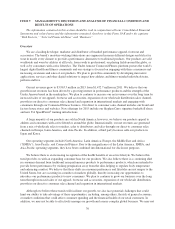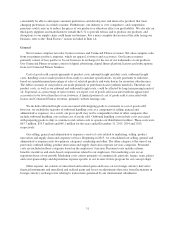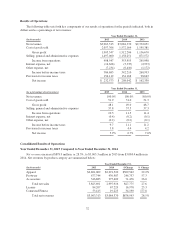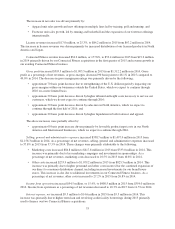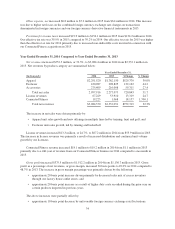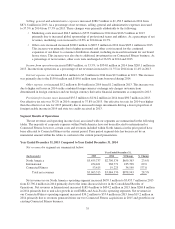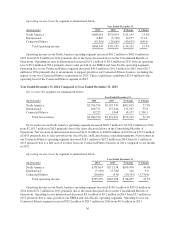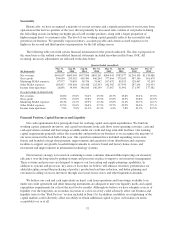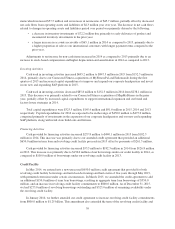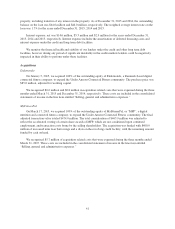Under Armour 2015 Annual Report Download - page 39
Download and view the complete annual report
Please find page 39 of the 2015 Under Armour annual report below. You can navigate through the pages in the report by either clicking on the pages listed below, or by using the keyword search tool below to find specific information within the annual report.consistently be able to anticipate consumer preferences and develop new and innovative products that meet
changing preferences in a timely manner. Furthermore, our industry is very competitive, and competition
pressures could cause us to reduce the prices of our products or otherwise affect our profitability. We also rely on
third-party suppliers and manufacturers outside the U.S. to provide fabrics and to produce our products, and
disruptions to our supply chain could harm our business. For a more complete discussion of the risks facing our
business, refer to the “Risk Factors” section included in Item 1A.
General
Net revenues comprise net sales, license revenues and Connected Fitness revenues. Net sales comprise sales
from our primary product categories, which are apparel, footwear and accessories. Our license revenues
primarily consist of fees paid to us by our licensees in exchange for the use of our trademarks on our products.
Our Connected Fitness revenues consist of digital advertising, digital fitness platform licenses and subscriptions
from our Connected Fitness business.
Cost of goods sold consists primarily of product costs, inbound freight and duty costs, outbound freight
costs, handling costs to make products floor-ready to customer specifications, royalty payments to endorsers
based on a predetermined percentage of sales of selected products and write downs for inventory obsolescence.
The fabrics in many of our products are made primarily of petroleum-based synthetic materials. Therefore our
product costs, as well as our inbound and outbound freight costs, could be affected by long term pricing trends of
oil. In general, as a percentage of net revenues, we expect cost of goods sold associated with our apparel and
accessories to be lower than that of our footwear. A limited portion of cost of goods sold is associated with
license and Connected Fitness revenues, primarily website hosting costs.
We include outbound freight costs associated with shipping goods to customers as cost of goods sold;
however, we include the majority of outbound handling costs as a component of selling, general and
administrative expenses. As a result, our gross profit may not be comparable to that of other companies that
include outbound handling costs in their cost of goods sold. Outbound handling costs include costs associated
with preparing goods to ship to customers and certain costs to operate our distribution facilities. These costs were
$63.7 million, $55.3 million and $46.1 million for the years ended December 31, 2015, 2014 and 2013,
respectively.
Our selling, general and administrative expenses consist of costs related to marketing, selling, product
innovation and supply chain and corporate services. Beginning in 2015, we consolidated our selling, general and
administrative expenses into two primary categories: marketing and other. The other category is the sum of our
previously outlined selling, product innovation and supply chain and corporate services categories. Personnel
costs are included in these categories based on the employees’ function. Personnel costs include salaries,
benefits, incentives and stock-based compensation related to our employees. Our marketing costs are an
important driver of our growth. Marketing costs consist primarily of commercials, print ads, league, team, player
and event sponsorships and depreciation expense specific to our in-store fixture program for our concept shops.
Other expense, net consists of unrealized and realized gains and losses on our foreign currency derivative
financial instruments and unrealized and realized gains and losses on adjustments that arise from fluctuations in
foreign currency exchange rates relating to transactions generated by our international subsidiaries.
31


